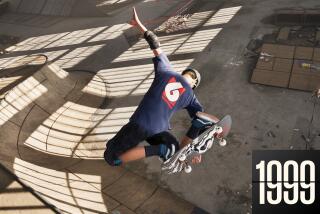T.HQ a Hero as Loyal Players Are Forgotten Bit by Bit
- Share via
I had lunch awhile back with Brian Farrell, president of Calabasas-based T.HQ Inc. and a game guy who hasn’t forgotten the 35 million of us nationwide who refuse to forsake our 16-bit rigs and 8-bit portables.
Those who love portable gaming will probably remember T.HQ as the company responsible for the great job porting Electronic Arts’ helicopter Strike series onto Game Boy and Game Gear. More recently, the company did the same thing for Disney Interactive’s Pocahontas and Toy Story.
And while Farrell and his staff are looking ahead to the 32-bit market, they still believe players without cash to burn deserve a steady diet of good games for their Super Nintendo and Sega Genesis machines.
“This year,” Farrell said, “I don’t see people walking away from their 16-bit machines.”
Especially if you consider that there are perhaps 15 times as many 16-bit machines floating around out there as the 2 million or so 32-bit rigs sold in the past few years. Yet game companies across the board are ditching their loyal customers as they become enamored of the technical ability of the new--but so far not ubiquitous--machines.
Over the next few months, Farrell plans to release 16-bit spinoff titles of the 1996 Summer Olympics in Atlanta. He also plans a couple of games he’s not talking much about--Time Killers for Genesis and Mohawk & Headphone Jack for Super Nintendo.
In addition, he told me to look out for the Bass Masters Classic Pro Edition for Super Nintendo. I razzed Farrell a little about a game that re-creates a sport not known for action, but he shut me up quickly by pointing out that the original Bass Masters fishing simulator sold 200,000 copies.
OK.
More in line with my tastes, though, was T.HQ’s first 32-bit title, In the Hunt, a submarine shooter for Sega Saturn and Sony PlayStation that is as fast and difficult as anything I’ve ever played.
The graphics look like they’re straight out of the arcades, but the sounds are a little dull, tending more along the lines of Ka-Boom and Bang than the kinds of audio cues that can really elevate a game.
I played for a few hours one weekend and ended up feeling like a wuss because I got wiped out on even the easiest levels. It has a nice continue feature, though, that allows action to resume from the point of last destruction.
All in all, a pretty nice game.
Also nice, though not my cup of tea, is Pocahantas for Game Boy--a port of the Disney Interactive title that emphasizes cooperation over competition. I love helping my furry friends as much as the next guy, but when I fire up a game machine, I want to blow something up.
Farrell himself concedes the game is for younger players, and I can see how they would dig the teamwork aspect of exploring the forest, which comes across fairly well on Game Boy’s frustrating liquid crystal screen.
Let’s hope that, as the shine wears off the new 32-bit machines, more companies follow the lead of T.HQ--which turned a profit for the first time this year--and not forget the millions of 16-bit players who feel a little left out nowadays.
Staff writer Aaron Curtiss reviews video games regularly. To comment on a column or to suggest games for review, send letters to The Times, 20000 Prairie St., Chatsworth, CA 91311. Or send e-mail to Aaron.Curtiss@latimes.com.




